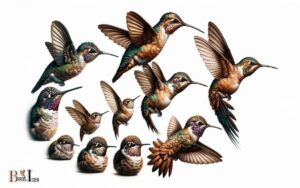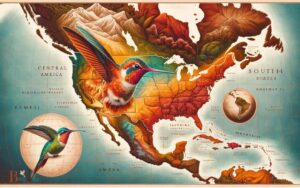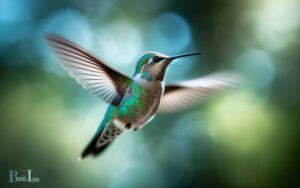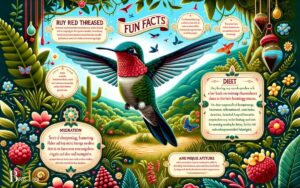Anna’s Hummingbird Calypte Anna: Characteristics!
Anna’s Hummingbird (Calypte anna) is a medium-sized hummingbird native to the west coast of North America. It is known for its iridescent emerald feathers and rose-pink throat and is often seen in backyards and gardens where feeders are present.
Anna’s Hummingbirds, scientifically known as Calypte anna, play a vital role in pollination. They have a unique flying ability that allows them to hover in mid-air by rapidly flapping their wings 40-50 times per second.
This species exhibits sexual dimorphism: males have a brilliant rose-pink throat and head that can look dull brown or gray without the correct lighting, while females have a more subdued color palette.
They feed primarily on nectar from flowers and feeders, as well as insects and spiders for protein. Anna’s Hummingbirds are adaptable and have expanded their range, even being found in urban areas.
The vibrant plumage and dynamic flight patterns of Calypte anna make Anna’s Hummingbird a captivating subject for bird enthusiasts and a delightful visitor to gardens along the Pacific Coast.
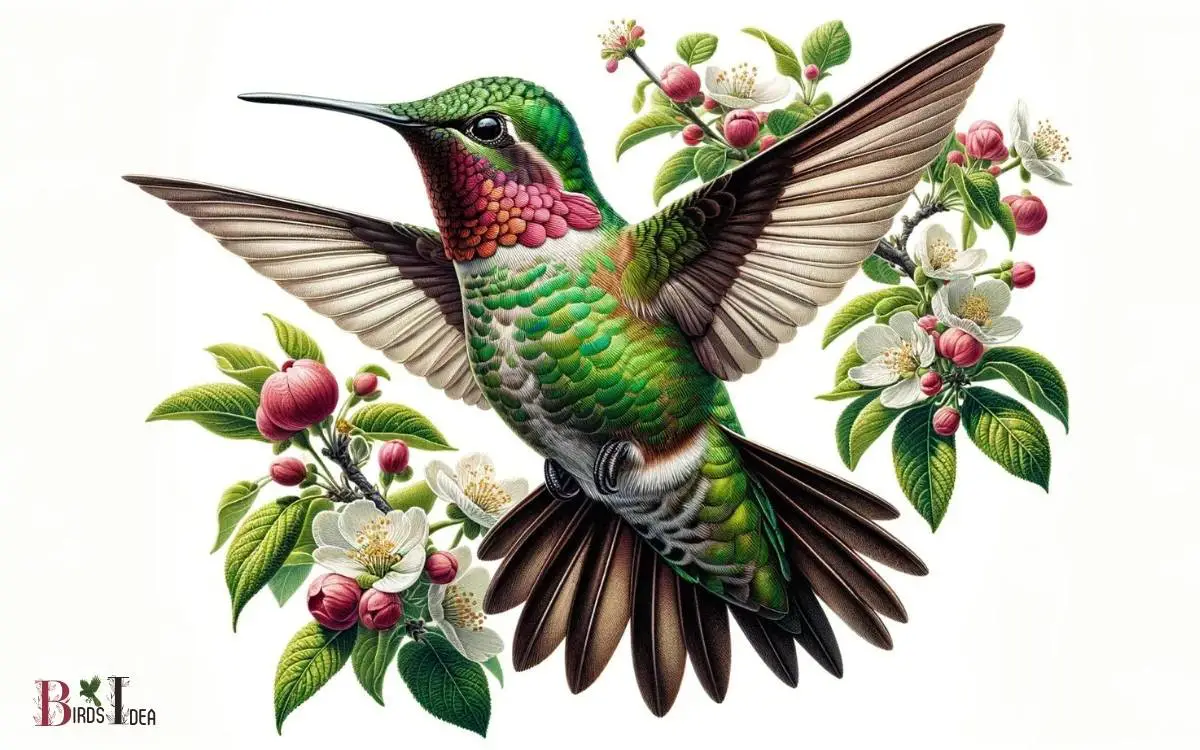
Key Takeaway
Physical Characteristics
The physical characteristics of Anna’s Hummingbird, Calypte Anna, include vibrant plumage and a compact body structure that enables agile flight.
The male has iridescent pinkish-red feathers on its head and throat, which appear dull brown or gray in dim light, while the female has green and gray plumage with specks of red on its throat.
Both genders have a slender, streamlined body, with a length of about 3.9 inches and weigh approximately 0.1-0.2 ounces.
Their wings can beat at a remarkable rate of approximately 60 to 80 times per second, allowing them to hover and maneuver with great precision.
Additionally, they have a long, needle-like bill and a specialized tongue for feeding on nectar. These physical attributes collectively contribute to the remarkable agility and beauty of the Anna’s Hummingbird.
Habitat and Range
The habitat and range of the Anna’s Hummingbird, Calypte Anna, encompass a variety of preferred nesting locations, including gardens, woodlands, and coastal scrub.
Their geographic distribution spans along the western coast of North America, from southern Canada to northern Baja California, with a preference for temperate climates.
Additionally, their migration patterns and behavior exhibit interesting adaptations to changes in environmental conditions and food availability.
Preferred Nesting Locations
An important consideration for understanding the nesting behavior of the Anna’s Hummingbird Calypte Anna is to examine its preferred habitat and range.
These hummingbirds are primarily found along the western coast of North America, from southern Canada to northern Baja California in Mexico.
Their preferred nesting locations include:
- Coastal Scrub: Anna’s Hummingbirds are commonly found in coastal scrub areas with a mix of shrubs, trees, and open spaces, providing them with suitable locations to build their nests.
- Urban and Suburban Areas: These adaptable birds have also been known to nest in urban and suburban environments, utilizing gardens, parks, and residential areas with suitable vegetation.
- Wooded Habitats: Additionally, they may nest in wooded habitats, especially those with a variety of flowering plants for food sources.
Understanding their nesting preferences is crucial for conservation efforts and providing suitable habitats for these vibrant birds.
Geographic Distribution and Climate
Geographic distribution and climate significantly influence the habitat and range of the Anna’s Hummingbird Calypte Anna, shaping its nesting preferences and ecological requirements.
These hummingbirds are primarily found along the western coast of North America, from southern Canada to northern Baja California in Mexico.
They thrive in diverse habitats such as coastal scrub, oak woodlands, and urban areas, preferring open spaces with access to flowering plants for nectar.
The mild coastal climate of their range provides them with a consistent and suitable environment for foraging and nesting.
However, they have also adapted to human-altered landscapes, expanding their range into urban and suburban areas.
This adaptability to varying climates and habitats has enabled the Anna’s Hummingbird to establish itself as a common sight in many parts of its range.
Migration Patterns and Behavior
Influenced by environmental factors, including weather and resource availability, the migration patterns and behavior of the Anna’s Hummingbird Calypte Anna are essential aspects of its habitat and range.
These tiny birds exhibit fascinating behaviors related to their migration, including:
- Long-distance travelers: Anna’s Hummingbirds are known to migrate over long distances, with some individuals traveling up to 1,200 miles between their breeding and wintering grounds.
- Altitudinal migration: They also display altitudinal migration, moving to higher elevations during the breeding season and descending to lower elevations in winter.
- Territorial behavior: During migration, these hummingbirds fiercely defend their feeding and nesting territories, often engaging in aggressive displays to protect vital resources.
Understanding these migration patterns and behaviors is crucial for conserving suitable habitats and ensuring the survival of this remarkable species.
Feeding Behavior
The feeding behavior of the Anna’s Hummingbird revolves around nectar as its primary food source. This species is known for its aggressive territorial behavior, especially around nectar-rich areas.
Understanding the feeding habits and territorial nature of these hummingbirds provides insight into their ecological role and survival strategies.
Nectar as Primary Food
As nectar serves as the primary food source for Anna’s Hummingbirds, their feeding behavior is crucial to their survival and energy requirements.
These remarkable birds have evolved specific feeding behaviors to efficiently obtain nectar and meet their dietary needs.
- Hover-feeding: Anna’s Hummingbirds are adept at hovering in mid-air as they extract nectar from flowers using their specialized long, slender bills. This unique ability allows them to access nectar from a wide variety of flowers.
- Territoriality: These hummingbirds exhibit territorial behavior around their food sources, aggressively defending their feeding territories from intruders, ensuring a consistent nectar supply.
- High Metabolic Rate: Due to their small size and high metabolic rate, Anna’s Hummingbirds need to feed frequently, visiting hundreds of flowers each day to meet their energy demands.
This specialized feeding behavior highlights the importance of nectar as the primary food source for Anna’s Hummingbirds.
Aggressive Territorial Behavior
Aggression characterizes Anna’s Hummingbird’s territorial behavior in the context of feeding.
These birds fiercely defend their food sources, often engaging in aggressive displays towards other hummingbirds, insects, or even larger birds that encroach upon their feeding territories.
Anna’s Hummingbirds are known for their bold and assertive nature, using rapid and direct flight patterns to intimidate intruders. They may also emit sharp chirping sounds or perform aerial displays to deter competitors.
This aggressive behavior is driven by the necessity to secure adequate food resources, particularly nectar and small insects, which are crucial for their high metabolic rates.
By fiercely defending their feeding territories, Anna’s Hummingbirds ensure sustained access to the energy-rich food they need to thrive and survive.
Breeding and Nesting
During the breeding season, Anna’s Hummingbirds construct small cup-shaped nests using plant fibers and spider silk.
The female hummingbirds are solely responsible for building the nests, which are typically located in the branches of trees, shrubs, or sometimes even in human-made structures.
The nests are often camouflaged with lichen or moss to blend in with their surroundings and provide a safe environment for the eggs and chicks.
Once the nest is ready, the female lays two pea-sized eggs, which she incubates for about 14 to 19 days. After hatching, the chicks are fed a diet of regurgitated nectar and insects until they are ready to leave the nest.
- Female hummingbirds construct the nests alone
- Nests are camouflaged with lichen or moss
- Chicks are fed a diet of regurgitated nectar and insects
Mating Displays
While building the nests, female Anna’s Hummingbirds may also display intricate mating rituals to attract potential mates.
These displays often involve the female performing acrobatic flights and showing off her vibrant iridescent feathers to impress the males.
The males, in turn, showcase their colorful plumage and perform high-speed dives and U-shaped courtship flights to court the females. These elaborate displays are crucial for mate selection and pair bonding.
The intricate nature of these mating rituals highlights the significance of visual cues in the courtship behavior of Anna’s Hummingbirds.
These mating displays are just one aspect of the complex communication system of Anna’s Hummingbirds.
Vocalizations also play a vital role in their interactions, allowing them to convey information about food sources, territory boundaries, and potential threats.
Vocalizations and Communication
Communication in Anna’s Hummingbirds involves intricate vocalizations that serve as crucial signals for conveying information about food sources, territory boundaries, and potential threats.
These tiny birds use a variety of vocalizations to express themselves, including:
- Squeaks and Chirps: Anna’s Hummingbirds produce high-pitched squeaks and chirps to establish territory boundaries and attract mates.
- Whistles and Trills: During courtship and mating displays, these hummingbirds emit melodious whistles and trills to communicate their interest and readiness to mate.
- Chattering: When feeling threatened or alarmed, Anna’s Hummingbirds emit rapid chattering sounds to warn others and signal potential danger.
These vocalizations play a vital role in the hummingbirds’ daily interactions, helping them navigate their environment and communicate effectively with other members of their species.
Migration Patterns
Migrating annually, Anna’s Hummingbirds travel between breeding and wintering grounds, covering vast distances along the Pacific Coast of North America.
These tiny birds exhibit remarkable migration patterns, with some individuals traveling up to 1,250 miles between their summer and winter habitats.
The table below highlights the incredible journey of Anna’s Hummingbirds, showcasing the distances they cover and the challenges they encounter during their migration.
| Migration Stage | Distance Covered | Challenges Encountered |
|---|---|---|
| Breeding to Wintering | Up to 1,250 miles | Predation, weather |
| Wintering to Breeding | Up to 1,250 miles | Food scarcity |
| Breeding to Foraging | Within 5-10 miles | Competition for nectar |
These migration patterns demonstrate the resilience and adaptability of Anna’s Hummingbirds as they navigate their way through diverse ecosystems to ensure their survival.
Conservation Status
Despite their remarkable migration patterns, the conservation status of Anna’s Hummingbirds is a subject of concern for researchers and conservationists.
The species faces several threats that impact its long-term survival, including:
- Habitat Loss: Urbanization and land development are leading to the destruction of the hummingbird’s natural habitats.
- Climate Change: Shifts in climate patterns are affecting the availability of nectar and insects, which are essential food sources for the hummingbirds.
- Pesticide Use: Exposure to pesticides, particularly those used in agricultural areas, can have detrimental effects on the health and reproduction of Anna’s Hummingbirds.
Efforts are being made to address these challenges through habitat conservation, education, and advocacy to ensure the continued presence of these captivating birds in our ecosystems.
Conclusion
The Anna’s hummingbird, Calypte anna, is a stunning and fascinating bird with its vibrant coloring and remarkable feeding behavior.
Found in a variety of habitats along the western coast of North America, this species displays unique mating behaviors and vocalizations.
Despite facing threats from habitat loss and climate change, the Anna’s hummingbird continues to captivate and inspire bird enthusiasts with its incredible agility and beauty, making it a true gem of the avian world.

